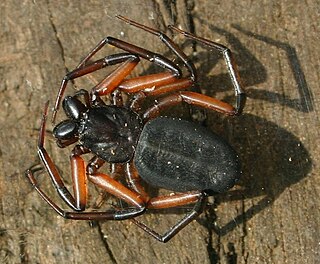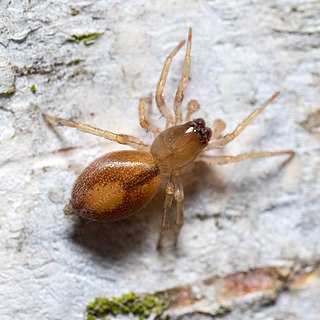
Wall spider is the common name for members of the genus Oecobius in the family Oecobiidae. The members of these several species are all small spiders that make small flat webs over crevices in walls and in similar spaces. They are cribellate spiders, meaning that they produce silk through a sieve-like plate of many parallel spigots, so that it emerges in a bundle of many invisibly fine parallel fibres with no adhesive covering to glue them together. Instead the bundles part into separate woolly cables that readily entangle small prey items, such as ants, that run into them. The spider sits in middle of the web, and when it is disturbed by suitable prey, it runs out and circles the prey with more silk to tangle it further. It subdues the prey by biting it, and carries one or more items bundled in silk, seeking a refuge where it can feed.

Trochanteriidae is a family of spiders first described by Ferdinand Karsch in 1879 containing about 52 species in 6 genera. Most are endemic to Australia though Doliomalus and Trochanteria are from South America and Plator is from Asia. Platyoides species exist in southern and eastern Africa, Madagascar, and the Canary Islands with one species, P. walteri, introduced to Australia.

Synaphridae is a family of spiders with thirteen described species in three genera. It was first described as a subfamily of Anapidae, but it has since been raised to family status.

Dysdera is a genus of woodlouse hunting spiders that was first described by Pierre André Latreille in 1804. They originated from Central Asia to Central Europe.

Pholcus is a genus of spiders of long-bodied cellar spider and allies in the family Pholcidae, with 375 described species as of January 2023.

Walckenaeria is a genus of dwarf spiders that was first described by John Blackwall in 1833. It is a senior synonym of Paragonatium, as well as Wideria, Cornicularia, Prosopotheca, Tigellinus, and Trachynella.

Lasaeola is a genus of comb-footed spiders that was first described by Eugène Louis Simon in 1881. The type species was described under the name Pachydactylus pronus, but was renamed Lasaeola prona when it was discovered that the name "Pachydactylus" was preoccupied. Both this genus and Deliana were removed from the synonymy of Dipoena in 1988, but many of these species require more study before their placement is certain.
Spermophorides is a genus of cellar spiders that was first described by J. Wunderlich in 1992.

Apostenus is a genus of liocranid sac spiders that was first described by Niklas Westring in 1851.
Synaphris is a genus of araneomorph spiders in the family Synaphridae, and was first described by Eugène Louis Simon in 1894. Originally placed with the tangle web spiders, it was moved to the Symphytognathidae in 1973, and to the Synaphridae in 2003.
Pulchellodromus is a genus of running crab spiders that was first separated from Philodromus by J. Wunderlich in 2012.
Canariphantes is a genus of dwarf spiders that was first described by J. Wunderlich in 1992. It might be a junior synonym of Lepthyphantes.
Frontiphantes is a monotypic genus of European dwarf spiders containing the single species, Frontiphantes fulgurenotatus. It was first described by J. Wunderlich in 1987, and has only been found in Portugal.
Zimirina is a genus of long-spinneret ground spiders that was first described by R. de Dalmas in 1919. It was transferred to the ground spiders in 2018, but was returned to Prodidominae in 2022.
Minicia is a genus of dwarf spiders that was first described by Tamerlan Thorell in 1875.
Scotargus is a genus of sheet weavers that was first described by Eugène Louis Simon in 1913.
Eurypoena is a monotypic genus of comb-footed spiders containing the single species, Eurypoena tuberosa. The species was first described by J. Wunderlich in 1992 who then created the genus in 1992. It is found on the Canary Islands.

Paidiscura is a genus of comb-footed spiders that was first described by Allan Frost Archer in 1950.

Bassaniodes is a genus of crab spiders that was first described by Reginald Innes Pocock in 1903.

Porrhoclubiona is a genus of sac spiders that was first described as a subgenus of Clubiona by H. Lohmander in 1944. Clubiona is a polyphyletic group that has been divided and reorganized many times, and whether this genus is a synonym of Clubiona or an independent genus is still under debate.










